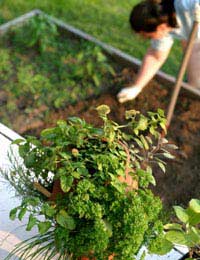Eelworms and How to Tackle Them

Although some types of eelworms are beneficial, helping to control vine weevils by killing their soil-dwelling grubs, many other kinds are serious and persistent pests which affect a wide range of common garden plants. Unfortunately there is no effective pesticide available to the home gardener to deal with these small nematode worms; the only hope of control lies in good management, careful selection of the plant stock and ruthless eradication of infected material.
Plants Affected
Many herbaceous plants including Chrysanthemums and Weigela, vegetables such as onions, peas, beans, carrots and potatoes, cucumber, lettuce, tomato and other salad crops along with soft fruits – most especially strawberries – are prone to attack by various types of eelworms.Leaf and Bud Eelworms
Mainly a problem of late summer or early autumn, the foliage of affected plants at first turns yellow, before eventually going dark brown as the nematodes within move along the larger veins in the leaves. Initially the attack is in relatively small patches, usually in the older, lower leaves but in time as the eelworms spread, the whole leaf is affected and the infestation passes up the stem, appearing in the newer leaves too. Some plants such as Buddleias show little leaf discolouration but produce severely undersized flowers as a result of eelworm attack.The worms spread more rapidly when the foliage stays wet for long periods – so times of prolonged rains or heavy dews are particularly dangerous.
To help control these pests, susceptible plants should ideally be watered at the root rather than wetting the leaves and stems, to reduce the chance of any infestation spreading; badly affected plants need to be removed and burnt.
Potato Cyst Eelworms
These worms are principally a pest of tomatoes and potatoes. When attacked, the leaves behave as before, turning yellow then black, before the stem becomes affected and the whole plant undergoes an early die-back. Only small sized potatoes are produced and careful examination of the plant’s roots will reveal spherical 1mm cysts – the heavily swollen bodies of gravid females – each containing upwards of 500 eggs. Left alone, the cysts will eventually turn brown and the eggs within can remain viable for years, which makes re-infection almost inevitable.Interestingly there is a bit of a North-South divide in cyst eelworms – with the white cyst eelworm (Globodera pallid) being the most commonly encountered species north of Yorkshire and Lancashire, with the related golden cyst eelworm (Globodera rostochiensis) predominating to the south.
Irrespective of type, control is the same – rotate potato and tomato growing around the garden to circumvent the danger of eggs building up in the soil – and avoid re-using the same space for as many growing season as you can to reduce the viability of any that do remain. A heavily infested soil may need six or seven potato-free years before you can safely replant it.
Burning the roots rather than adding them to the compost heap is another useful way to control eelworm numbers. There are also some potato cultivars which have natural resistance to cyst eelworms so if they are a particular problem in your garden or area, it may be worth investigating if any are suitable for your needs.
With such a persistent pest, controlling eelworms can sometimes seem a real uphill struggle and there’s no escaping the fact that it’s not an easy job. However, although you may never eradicate them entirely from your soil, with care you should be able to minimise the worst of their effect.
- Can You Spot the Signs of Pests?
- Effective Pest Control For Moths and Gnats
- Store Cupboard Pests
- Grey Squirrels
- Treating and Preventing Fleas
- Earwigs, Cockchafers and Other Occasional Invaders
- Flies: Houseflies and Bluebottles
- How to Tackle Booklice
- Urban Foxes: How to Minimise Their Visits
- Bees and Wasps
- Head, Body and Pubic Lice Explained
- Problems With Feral Pigeons
- Rats and Mice
- How to Deter Moles from Your Garden
- Ant Invasion: Dealing With Ants
- Bats in Britain
- Beetles and Cockroaches
- Snails and Slugs
- Bed Bugs and How to Deal With Them


Re: Do Rabbit Droppings Attract Mice or Rats?
Except for rat droppings, how can I tell if a rat or mouse has been eating my rabbits food? This morning I…
Re: Do Rabbit Droppings Attract Mice or Rats?
Get a cat! They will at least chase (and maybe kill or maim) a mouse or rat!!!
Re: Do Rabbit Droppings Attract Mice or Rats?
I have my two bunnies as backyard bunnies. I got a bit lazy and had left Cheerios (their favorite treat) out on…
Re: Flies: Houseflies and Bluebottles
I my first-floor flat, (whose windows are normally closed because of traffic noise) I have, in last few days, suddenly had…
Re: Do Rabbit Droppings Attract Mice or Rats?
Excuse my ignorance but I need to clarify something. Someone wrote in about finding a rat inside the cage with…
Re: Do Rabbit Droppings Attract Mice or Rats?
I have a pet rabbit and have just had to try and chase a wild mouse out of the room its now down in the walls of…
Re: Flies: Houseflies and Bluebottles
My daughter lives in a ground floor flat an has had a major fly problem all the time she's been there 18 months. These are…
Re: Flies: Houseflies and Bluebottles
Inundated with house flies - small but two days running in my kitchen and sitting room - keeping doors to rest of flat shut.…
Re: Flies: Houseflies and Bluebottles
For the past days flies have been appearing one at a time, up to 30 a day. There is no smell and we cant find any food etc.…
Re: Flies: Houseflies and Bluebottles
@Ry - I know how you feel. It seems to be worse in August. I think it's the fact that our bins are only emptied once a…